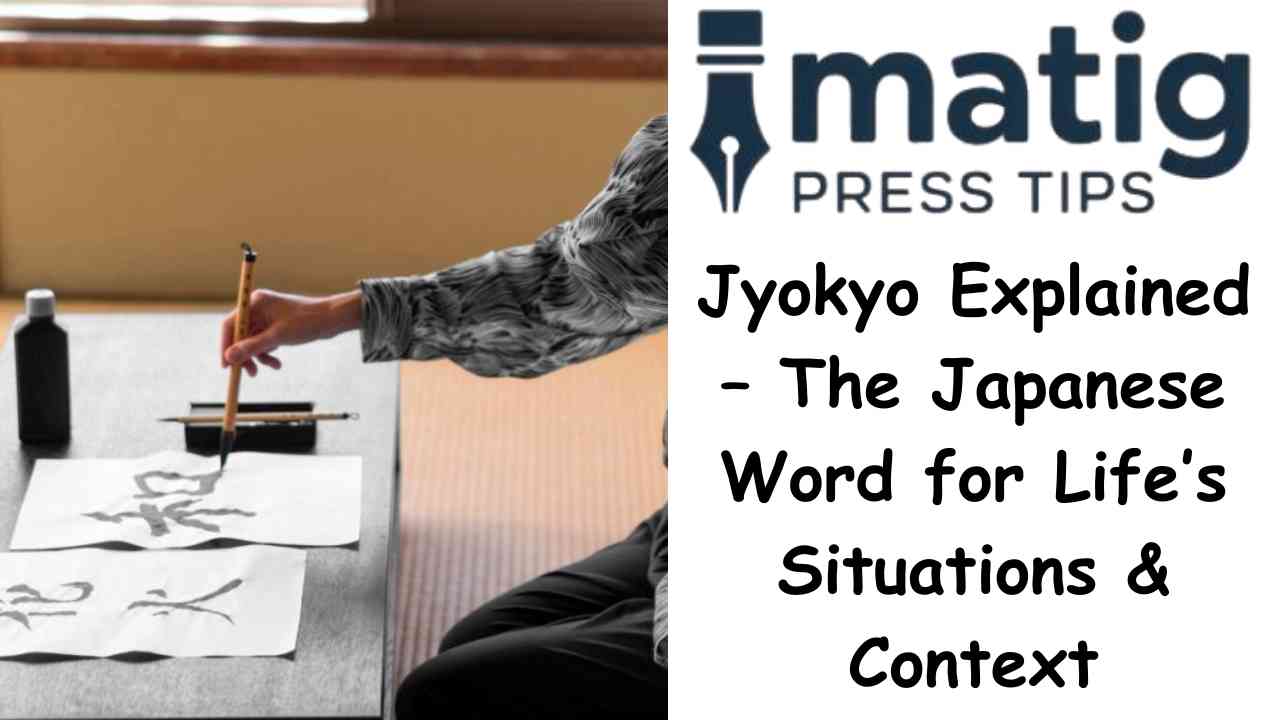I want you to imagine we’re sitting at a cozy little café, under soft lighting, the hum of conversations floating around. You stir your tea and lean in: “Hey — what does ‘jyokyo’ mean in Japanese? I saw it in a manga and got curious.”
That’s exactly the kind of question I love — simple on the surface, but with deeper roots. So today, let’s unpack jyokyo together: its literal meaning, its nuance, its usage, and a little wandering into temples (because why not add a bit of spiritual ambiance?). By the end, I hope “jyokyo” feels more than a word to you — more like a lens into Japanese thinking.
What is “jyokyo” (状況) — basic meaning?
First, the short answer (so you feel grounded): jyokyo (often romanized jōkyō, sometimes simplified as jyokyo) is a Japanese noun meaning “situation,” “circumstance,” or “condition.” It refers to the surrounding context of events or a person’s state of affairs.
You’ll see definitions like:
- “Situation” or “circumstance” (i.e. 状況 means the condition or scenario someone finds themselves in)
- “Condition or environment around someone or something” (not just what’s happening, but how things are happening)
So in English, if you ask, “What’s your jyokyo?”, you’re not just asking how are you? — more like “What’s going on around you? What’s your condition, your challenges, your setting?”
But — and here’s where a casual chat gets fun — jyokyo is more than translation. It carries weight, cultural nuance, and usage quirks that make it richer than “situation” alone. Let’s dig in.
Breaking it down: origin, kanji & nuance
When you peek at the kanji, you see some hints about depth.
- 状 (jō / jō-) means “condition,” “form,” or “state.”
- 況 (kyō / kyō) means “situation,” “circumstance,” sometimes hinting at how things are proceeding.
Put them together (状況), and you get a word that suggests not just a static “state” but presence, context, and movement. The nuance: jyokyo often implies “this is how things are unfolding,” with all the implications and subtext.
One article puts it well: “In everyday Japanese … you’ll often see it translated simply as ‘situation,’ ‘condition,’ or ‘circumstance.’ Yet … it functions as a lens — a way to sense the mood, constraints, and subtleties around a moment.”
So jyokyo in English is rough — you can say “situation,” but you risk losing the undercurrents.
A language blog mentions: “What Does Jyokyo Mean? In its simplest sense, Jyokyo (状況) means situation or circumstance… it refers to the conditions surrounding a person, an event, or an environment.”
I like to think of jyokyo as “the stage on which life plays out” — not just the actors or the script, but the backdrop, lighting, and mood.
How is “jyokyo” used in Japanese speech?
Alright — how do real people use it? Because the meaning comes alive in context.
Example sentences
- 彼の状況は複雑だ。
- Kare no jyokyō wa fukuzatsu da.
- → His situation is complicated.
- 今の状況を説明してください。
- Ima no jyokyō wo setsumei shite kudasai.
- → Please explain the current situation.
- そういう状況では、無理でしょう。
- Sō iu jyokyō dewa, muri deshō.
- → In a situation like that, it’d be impossible, I guess.
Notice how “situation” in those isn’t exactly sterile or detached — there’s emotional weight, expectation, implication.
Why Japanese like this word?
In Japanese communication, indirectness and context matter a lot. People often avoid blunt statements. Jyokyo helps frame issues delicately: it lets someone refer to “the situation” without naming blame or diving into harsh specifics.
Also, a culture that values harmony (wa, 和) appreciates how expressions like jyokyo allow nuance. Saying “In the given situation…” can soften a request or critique.
One feature article titled “7 Key Facts About Jyokyo Every Japanese Learner Should Know” describes how the word is a window into the Japanese mindset: language reflecting a holistic view — things are rarely isolated; they are embedded in context.
Potential confusions: jōkyō, jyokyo, & “going to the capital”
Here’s where things get interesting (and slightly confusing): the reading jōkyō / jyokyo can overlap with other words — same or similar pronunciation, but different characters and meanings.
上京 (じょうきょう, jōkyō / jokyō)
This is a completely different word, often romanized the same way, but meaning “going up to the capital” (historically, Kyoto; nowadays often Tokyo).
- Example: 彼は大学のために上京した → He went up to Tokyo (to study).
- “上” means “up,” “京” means “capital.”
When people see jyokyo / jōkyō, they might confuse 状況 (situation) with 上京 (going to the capital). So context (and often the kanji) is vital.
One dictionary entry (Tanoshii Japanese) shows 上京’s meaning: “proceeding to the capital (Tokyo).”
MailMate’s glossary also notes jokyo (上京) refers to the act of going to the capital city — historically Kyoto, now Tokyo.
So, when you see “jyokyo” in romaji, always check which kanji or context it belongs to.
Cultural mindset: Why “jyokyo” matters beyond translation
Language shapes worldview. Jyokyo is a window into how Japanese culture often frames things: not as isolated events, but in context, relationship, and condition.
To illustrate: suppose someone says, “今日は天気の状況が良くないから…” — “Because today’s situation/conditions (weather) aren’t good…” The speaker doesn’t blame the weather; says “situation” — a bit softer, acknowledging nuance.
It’s akin to English saying “given the circumstances” — you hint at complexity.
Another article frames jyokyo as a powerful concept shaping how people think of their life journeys, not just momentary problems — how constraints, opportunities, mood, and external forces play a role.
In practice, a Japanese speaker might use 状況 to refer to emotional states, workplace dynamics, or broad social environments — not just visas, weather, or politics. It’s flexible.
“Jyokyo Ji Temple”? — Did you mean a temple?
You asked about “Jyokyo Ji Temple.” I couldn’t find a reliable temple under exactly that name — “Jyokyo Ji” doesn’t have clear references in the sources I checked.
What I did find:
- Jokyoji Temple, located in Utsunomiya, Tochigi Prefecture. One source maps “Jokyoji Temple, Tochigi Utsunomiya.”
- Another reference: Jokyoji Temple (2025) – All You Need to Know BEFORE … — in Tokyo listings.
It’s possible that “Jyokyo Ji Temple” is a romanization variant or mishearing of Jokyo-ji or Jyokkyo-ji. Alternatively, people may confuse 上京 or 状況 with 寺 (ji, meaning temple) and assume “Jyokyo Ji” is a place.
If you can recall the prefecture, region, or even one character of the temple name, I’d love to help you pin it down more precisely.
Personal reflections: Where I’ve encountered “jyokyo”
I first stumbled on 状況 / jyokyo when reading Japanese manga (slice-of-life). A character would say things like “その状況は…” or “こんな状況だから…” as a lead-in to decisions or hesitation. It struck me — the word felt soft, ambient, not overt.
Later, in Japanese language classes, teachers explained it’s one of those “context words” that beginners often underrate but advanced learners use fluently. In my early attempt, I’d translate it rigidly as “situation,” but found native speakers would use it in ways that felt more atmospheric — “the situation around me,” “the underlying conditions.” Over time, I learned to think in jyokyo — not “what is this event,” but “what forces, constraints, feelings, conditions are at play.”
A friend of mine, learning Japanese, once texted: “今日のjyokyoが複雑すぎて…” — “Today’s jyokyo is too complicated.” I knew right away what she meant: everything’s tangled — work, relationships, expectations, pressures. Not just one problem.
That little usage taught me: jyokyo is emotional and thematic, not mechanical.
When & where to use “jyokyo” in your own Japanese?
Here’s how you might incorporate jyokyo if you’re learning or chatting:
- Describing life state
- 今日の状況はちょっと厳しいけど、頑張るよ。
- Kyō no jōkyō wa chotto kibishii kedo, ganbaru yo.
- → Today’s situation is a bit rough, but I’ll do my best.
- In business / workplace talk
- , 現在の状況を報告します。
- Genzai no jōkyō wo hōkoku shimasu.
- → I’ll report on the current status/situation.
- In storytelling/fiction
- , その村は洪水という状況にあった。
- Sono mura wa kōzui to iu jōkyō ni atta.
- → The village found itself in the circumstance of a flood.
Avoid using jyokyo if you want to say something like “I’m okay / I’m happy” — that’s better with 心情 (shinjō, feelings) or 気持ち (kimochi). 状況 is more external, not internal.
When speaking, sometimes it will be attached with その (that), 今 (current), or this/that context words: その状況, 今の状況. That helps place it.
Common mistakes & tips
- Mixing up 上京 and 状況: As I said earlier, jyokyo (状況) and jōkyō / jokyō (上京) are different. One is “situation,” the other is “going up to the capital.” Always check the kanji or context.
- Translating too literally: If you translate 状況 always as “situation,” you miss the nuance. Sometimes “state,” “conditions,” “circumstances,” or even “standings” fit better.
- Using it for pure emotion: Don’t use 状況 when you mean “I feel sad.” That’s 心情 or 気持ち territory.
- Forgetting the broader context: Since jyokyo suggests surroundings, make sure your sentence has some relation to conditions, constraints, or external factors.
Revisiting meaning, some more depth
Let’s reevaluate one more time, so you leave with clarity:
- Jyokyo (状況) = situation, circumstance, condition — with nuance, context, and recognition of surrounding forces.
- Jyokyo in English is often “situation/circumstance,” but those words lack the ambient sense 状況 carries.
- Jyokyo, Japanese meaning can’t be boiled down to one word — it’s a mindset word.
- Jyokyo Ji / Temple confusion likely stems from either misromanization or overlaps in pronunciation; I found Jokyoji Temple in Tochigi, possibly related.
If you’re writing, speaking, or reading Japanese, having jyokyo under your belt gives you a tool to talk about complex states more elegantly and respectfully. It reminds both speaker and listener: there’s more beneath the surface.
Closing thoughts
Language is like a mirror — subtle shifts in word-choice reveal deeper ways of seeing the world. Jyokyo is one of those words that seems simple from the outside — “situation” — but when you lean in, you see it captures context, implication, other voices, constraints, and texture.
Every time you hear or use 状況 / jyokyo (in conversation, manga, or daily life), remember: you’re evoking much more than an event. You’re evoking the stage, the mood, the backstage whispers.
If ever you want to explore more nuanced Japanese words like jyokyo, or try to pin down that temple name you heard, let me know. I’m always up for another language expedition over coffee.
(FAQs)
1. Is “jyokyo” a formal word in Japanese?
Yes and no. It’s neither archaic nor slang — fairly standard. In everyday talk, 状況 appears in news broadcasts, business contexts, manga, and conversations. But in casual chit-chat, people might skip it for simpler words — yet it still shows up frequently when nuance is needed.
2. How do you spell “jyokyo” correctly in Japanese characters?
It’s spelled 状況. The reading is jōkyō (romaji sometimes written jyokyo).
3. Can “jyokyo” refer to internal emotional states?
Usually not. Jyokyo refers to external conditions or context. For inner feelings, the Japanese tend to use words like 心情 (shinjō) or 気持ち (kimochi).
4. Is “Jyokyo Ji Temple” a real place?
I couldn’t find a definitive “Jyokyo Ji Temple” in credible sources. There is a Jokyoji Temple in Utsunomiya, Tochigi. Perhaps that’s what’s referenced. If you give me the region or kanji, I can help find the correct temple.
5. Does jyokyo have cultural weight beyond language?
Definitely, it reflects how Japanese speakers often think in relational and contextual terms, not in isolated absolutes. Using jyokyo is a nod to subtlety — that things are never just what they seem.




